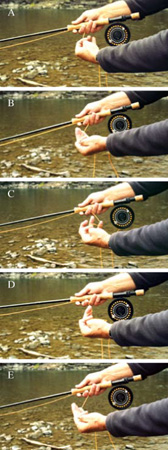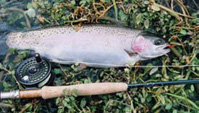Hand Twist
The hand twist retrieve is done by grasping the line between the line hand’s thumb and first two fingers and pulling an inch or two of line into the palm of your hand. Next, drop the pulled line and rotate the wrist so your fingers are back in the original position and repeat this procedure by grasping the line again. This retrieve is useful in making slow erratic motions; it imitates the majority of small aquatic food sources.

The distinguishing features between these basic retrieves are the distance that the fly moves. The speed can be varied for each. The longest of the retrieves is the pull. The intermediate one is the strip and the shortest one is the hand twist. Perhaps the strip retrieve is the most useful because it can provide the widest range of motions. The hand twist is best at making a short erratic motion; the pull can advance the fly for the longest distance.
Retrieve combinations are useful in mimicking the natural motions of insects and baitfish. Modifying these three basic retrieves can cause the fly to crawl, creep, pause, or move in steady, quick, erratic or twitching movements. The key is to match the retrieve to the natural motion of the insect you are imitating. The basic retrieve combinations are: sink-and-draw, lift-off-and-settle, rise-and-fall, wind drift, countdown, and skating. These retrieves are useful in still waters and in some slow current conditions.


© 2026 The Gale Group, Inc. All rights reserved.
© 2026 Perigee Learning LLC. All rights reserved.
LoveTheOutdoors.com is owned and operated by Advameg, Inc. © 2026 Advameg, Inc.
Camping Adventures • Dutch Oven Cooking • Sports Knots
Fly Tying • Freshwater Fishing • Fly Fishing

